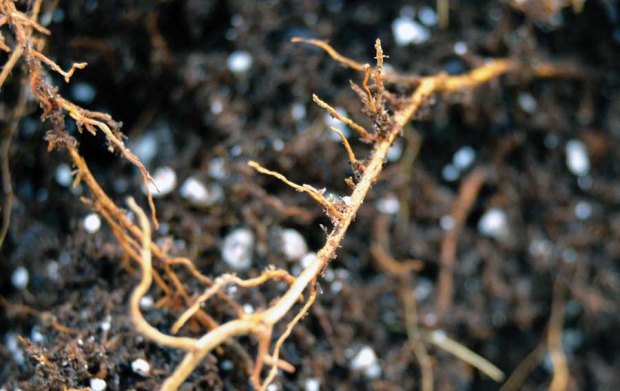
This apple tree’s branched root system is capable of scavenging nutrients from a large soil volume. (Courtesy Lee Kalcsits)
Starting from early orchard establishment and on to full fruit production, root health affects orchard performance, yield potential, and quality.
The most recognizable effect that roots have on growth of fruit trees comes from using dwarfing rootstocks that promote flowering at an earlier age, reduce shoot vigor, and limit overall tree size.
This habit allows for more efficient management of the canopy and increased planting densities and has led to the development of modern, trellised orchard systems to support high fruit production. Rootstocks affect flower bud induction, shoot growth, and fruit quality among many other horticultural traits.
However, some dwarfing rootstocks have slow or limited root growth potential. During planting and establishment of new orchards, this can be a challenge, particularly in poor soil environments where water and nutrients are being supplied almost exclusively through drip irrigation.
Poor root establishment and slow root growth can limit canopy establishment in early years and increase the susceptibility of the root to environmental stress because of the small, shallow root systems.
Orchard establishment
When an orchard is planted, early growth depends on root establishment to provide the resources required for the canopy to fill the space in the orchard. Early growth and development is critical to the productive success of an orchard.
Root systems with few fibrous roots or dried root systems can slow shoot growth until an active root system can be formed. Replant disease can also limit the growth potential of an orchard through a combination of fungal pathogens and nematodes that damage roots.
Fumigation and biological treatments can suppress many of these harmful organisms and allow the roots to grow more vigorously and the trees to fill trellis space in the orchard. Apple rootstocks in the Geneva series, developed by the U.S. Department of Agriculture in Geneva, New York, have shown promise for replant tolerance and early orchard establishment.
Water and nutrient uptake
Roots are responsible for water and nutrient uptake from the soil. Soil interacts with roots and soil chemical and physical characteristics can affect root growth. Healthy roots are critical for the plant to meet its water and nutrient needs. In roots, fine white root tips are responsible for most of the water and nutrient uptake from the soil.
As root tips mature, a waxy layer forms in the roots that limits water and nutrient uptake. Therefore, to have good water and nutrient uptake, there needs to be constant generation of white root tips. Under conditions of stress where root growth slows down or stops, water and nutrient uptake can be limited.
Sources of stress may include disease, drought, heat, pH, salinity, and flooding among others. In the orchard environment, managing your soil to be well-drained and uniform and to have a balanced pH are the first steps to promote healthy root growth.
Root growth over time
Root growth starts early in the spring prior to bud flush as soil temperatures warm. This provides early water uptake to supply the developing flowers and leaves. Early season nutrient requirements are largely met by stored nutrients in the roots and wood. As the growing season progresses and the energy sink of the plant switches from growing roots and stems to developing fruit, root growth decreases.
High soil temperatures (above 25°C or 80°F) can be a significant source of stress for roots. For dwarfing rootstocks with shallow, small root systems, the impact of temperature is greater. Increased stress may cause root mortality and/or decreased root tip growth, leading to a reduced capacity to take up water and nutrients from the soil.
Unlike above-ground growth, roots do not become dormant and will continue growing as long as conditions remain favorable. Therefore, roots can continue to grow long after the upper part of the tree has gone dormant and can scavenge nutrients later in the season to store for growth and development the following season.
Under conditions that lead to root death during the summer, the fall can act as a period to catch up and re-establish an active root system for the following season. Maintaining an environment that promotes root growth throughout the season and limits the below ground stress ensures that the trees can access water and nutrients at times during the season when the demand for those resources is high.
Understand how roots work
As planting densities continue to increase and technology allows for more precise control of orchard systems, it is critical to manage the timing of nutrient and water uptake. To do this, understanding what goes on below the tree is the first step. Grab a shovel and look at your roots to understand how they change during the season, where they grow, and how they respond to management changes.
It is also important to understand how roots respond to different scion varieties and the growth habits of different rootstocks. Healthy roots maintain or improve productivity and strengthen the foundation of your orchard’s success.
In December, the Washington State Horticultural Association’s annual meeting hosted a session on roots, which highlighted the critical role that roots play in future orchard success. The session included talks from Dr. Lee Kalcsits, Dr. Gennaro Fazio (USDA/ARS, Geneva), Dr. David Eissenstat (Pennsylvania State University), and Dr. Mark Mazzola (USDA/ARS, Wenatchee, Washington).
These talks can be viewed on the WSU College of Agriculture, Human, and Natural Resource Sciences’ YouTube Channel (tinyurl.com/nyrnwpj). The lively discussion that followed highlighted the strong interest and how more knowledge might translate into improved yield and better informed management decisions for tree fruit production.






Leave A Comment